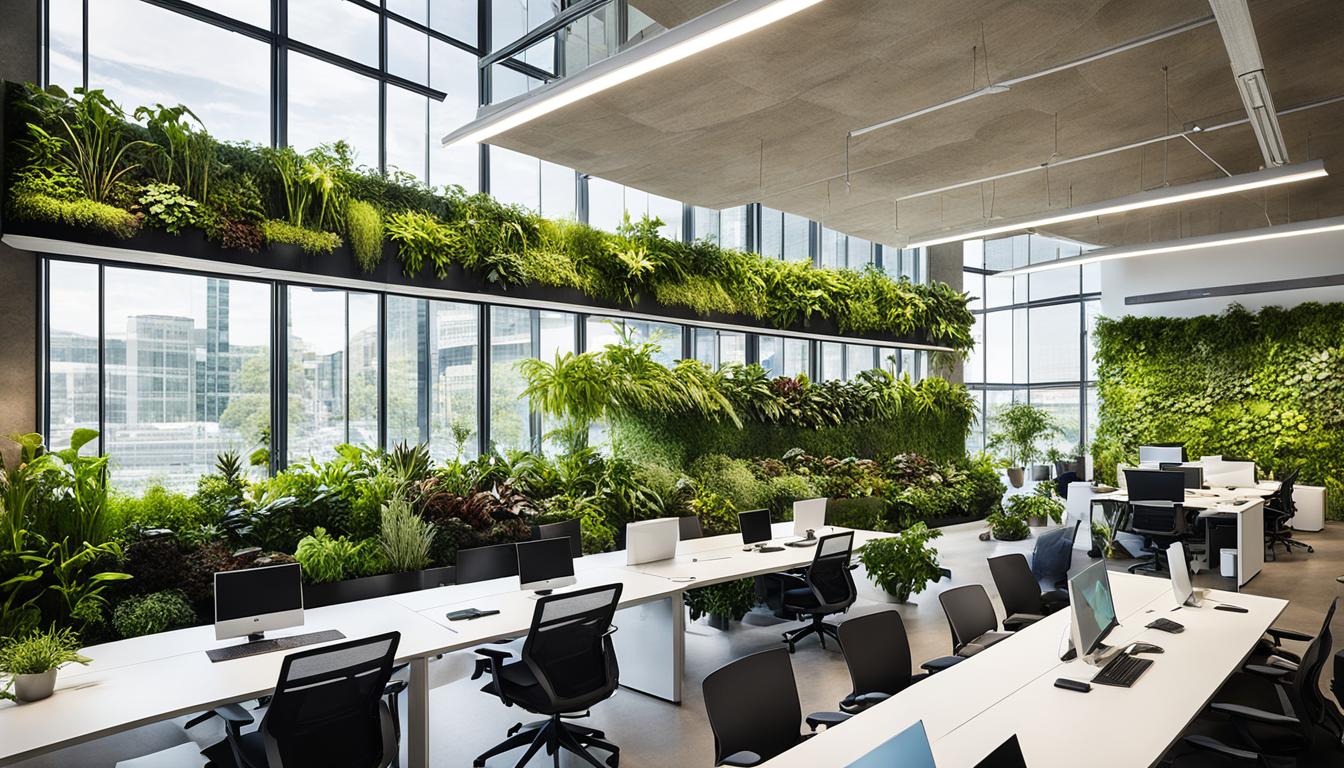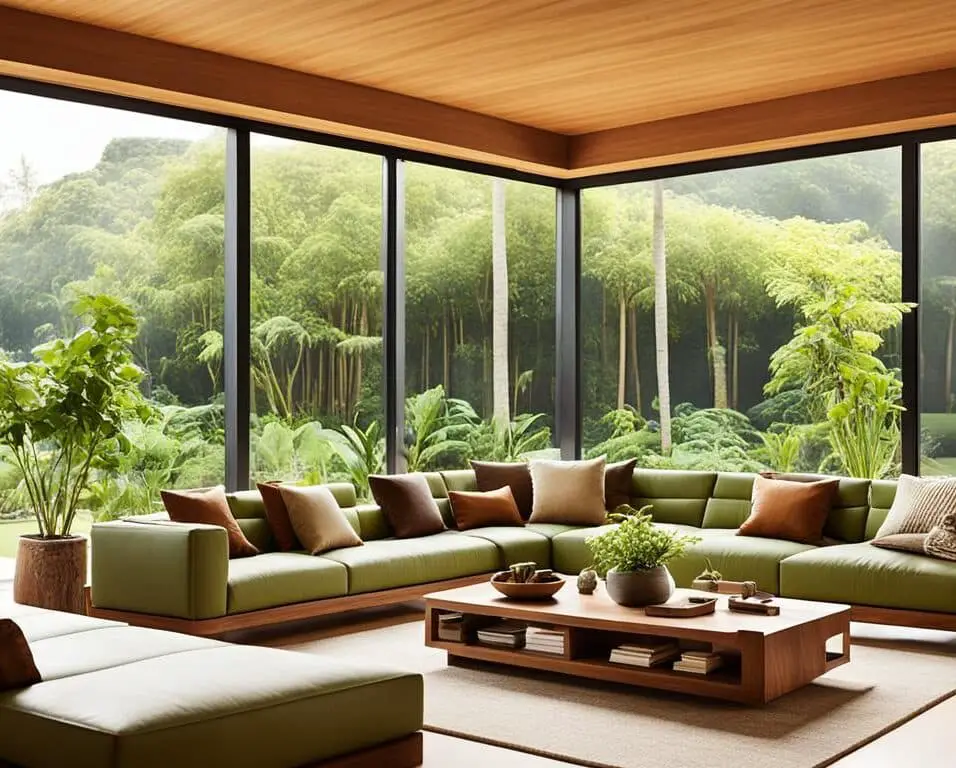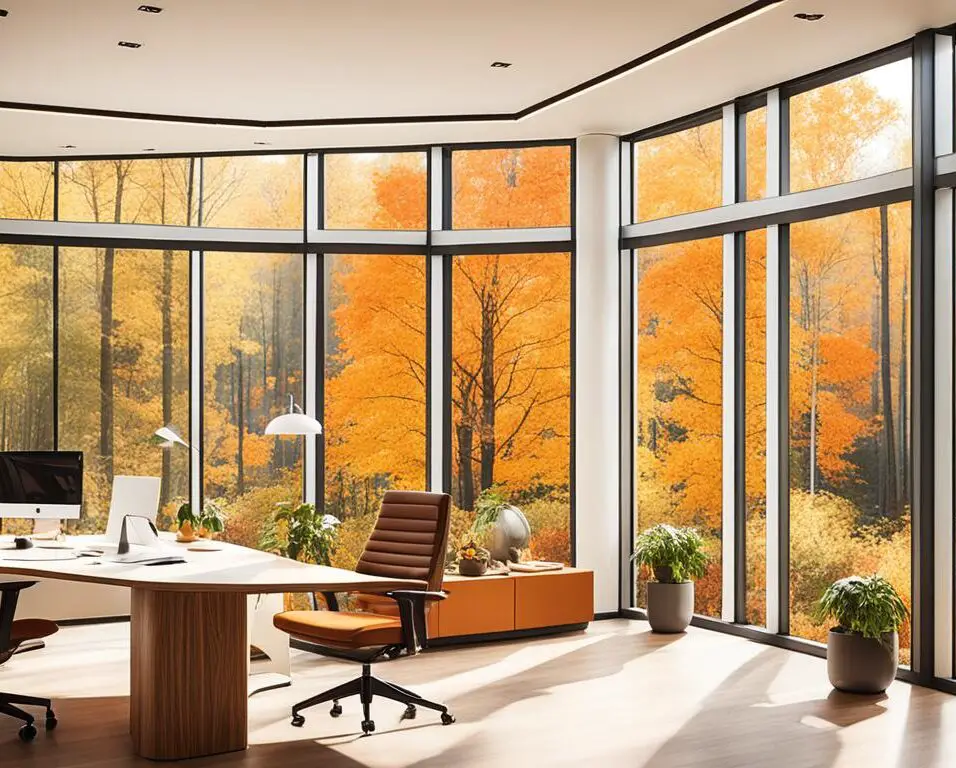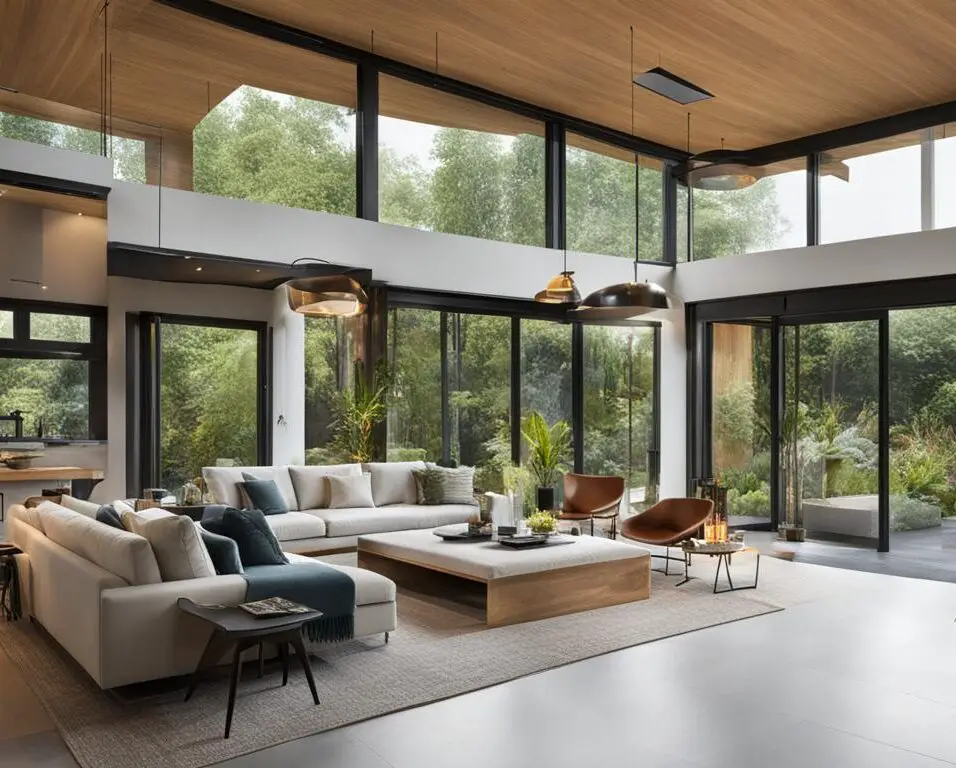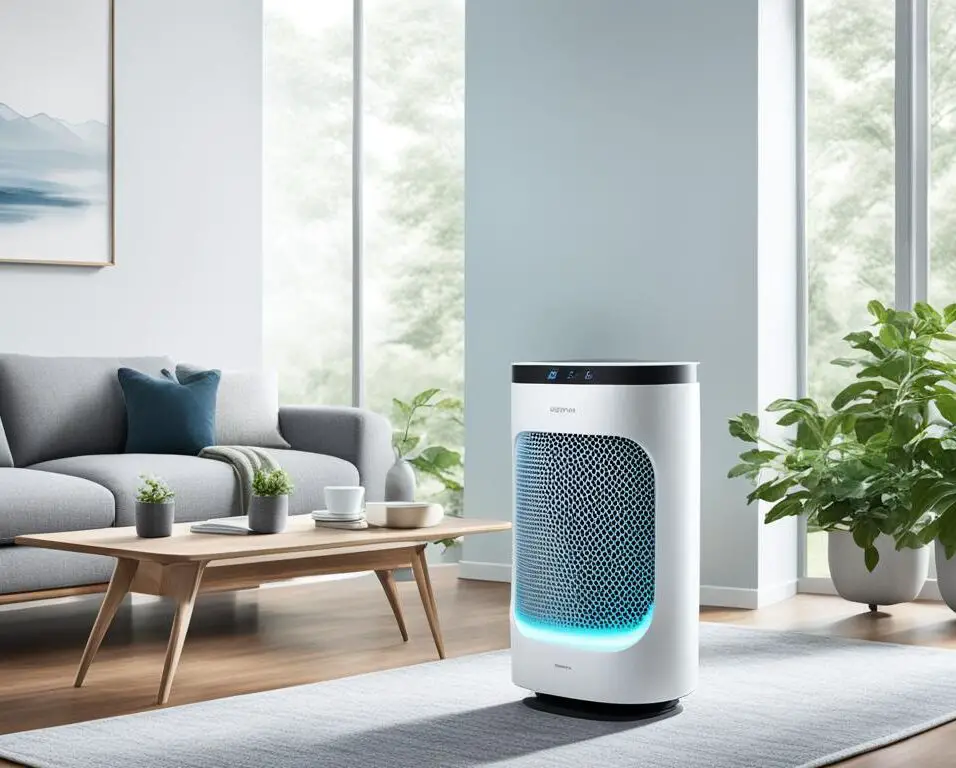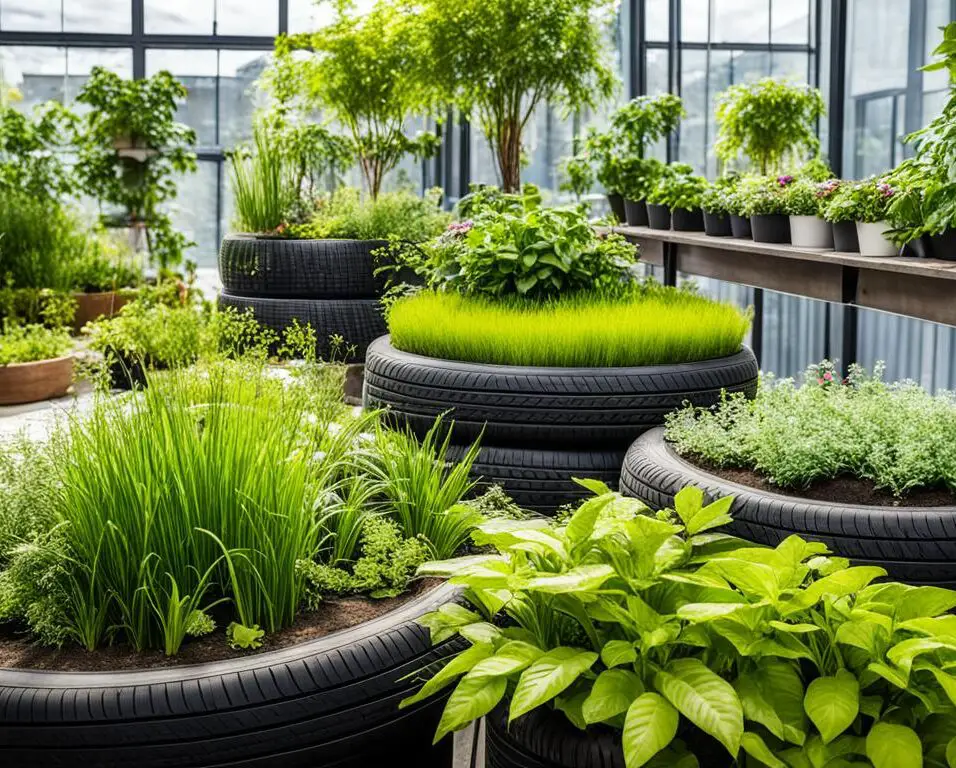Value Beyond Aesthetics: Biophilic Design’s Impact on Real Estate
I am excited to explore the fascinating world of biophilic design and its profound impact on the value of real estate. Biophilic design goes beyond mere aesthetics; it focuses on integrating elements of nature into the built environment, creating a harmonious and sustainable living space. By considering data from various sources, we will uncover how this design approach enhances habitation quality, improves physical and mental well-being, and attracts potential buyers or tenants.
Key Takeaways:
- Biophilic design enhances the value of real estate beyond its aesthetic appeal.
- Integrating elements of nature into the built environment has proven psychological and physiological benefits for occupants.
- Properties with biophilic design features are perceived as more desirable and can command higher prices or rental rates.
- Biophilic design has a significant impact on commercial real estate, improving productivity, employee satisfaction, and customer experience.
- Biophilic design aligns with sustainable development principles, reducing energy consumption and improving indoor air quality.
The Psychological and Physiological Benefits of Biophilic Design
Biophilic design offers more than just visual appeal; it has a profound impact on both the psychological and physiological well-being of individuals. Numerous studies have demonstrated the positive effects of biophilic design in reducing stress levels, boosting productivity, and enhancing cognitive function. Additionally, it contributes to improved air quality, acoustics, and natural lighting, which have a direct influence on physical health and overall well-being.
Exposure to nature or nature-inspired elements incorporated in biophilic design has been shown to have significant psychological benefits. This includes a reduction in stress levels, leading to improved mental health and a sense of well-being. Natural elements such as plants, water features, and natural materials create a soothing environment that promotes relaxation and tranquility.
“Biophilic design has the power to transform the built environment into a sanctuary that nurtures the mind and reduces stress.”
Physiological benefits are also evident in biophilic design. Improved air quality, achieved through the integration of green walls and living plants, contributes to better respiratory health. The presence of natural light and access to outdoor views enhances circadian rhythms and reduces the risk of sleep disturbances and associated health issues.
Studies have also shown that the use of natural materials and textures in biophilic design can positively impact cognitive function. The connection to nature stimulates creativity, enhances problem-solving abilities, and improves overall cognitive performance.
Overall, the combination of psychological and physiological benefits provided by biophilic design creates a holistic environment that promotes well-being and enables individuals to thrive. This approach to design not only enhances living and working spaces but also improves the quality of life for occupants.
Boosting Productivity through Biophilic Design
One of the significant psychological benefits of biophilic design is its positive impact on productivity. By incorporating elements inspired by nature in the workplace, such as green walls and natural light, employees experience increased focus, creativity, and engagement.
Research has found that employees in offices with biophilic design elements report higher levels of job satisfaction and well-being, resulting in improved productivity. Moreover, the introduction of nature-inspired elements in workspaces can reduce fatigue, enhance cognitive function, and improve employee mood and morale.
Studies have shown that exposure to natural environments or elements even for a short period can have a restorative effect on mental fatigue. Incorporating biophilic design in office spaces creates an environment that supports employees’ psychological and physiological needs, resulting in increased productivity and overall job satisfaction.
Enhancing Physical Health and Well-being
Biophilic design is not only beneficial for mental well-being but also contributes to improved physical health. Natural elements incorporated into the built environment, such as plants and green spaces, enhance air quality by reducing pollutants and providing increased oxygen levels.
Furthermore, biophilic design promotes better acoustics by incorporating natural materials that absorb sound and reduce background noise, creating a more peaceful and soothing environment. This contributes to reduced stress levels and improved overall well-being.
Biophilic design also prioritizes natural lighting, which enhances mood and supports the body’s circadian rhythm. By mimicking natural lighting patterns, occupants of biophilic spaces experience improved sleep quality, regulated hormone production, and increased vitamin D absorption.
Increased Property Value with Biophilic Design
By incorporating biophilic design elements into real estate properties, property value can be significantly increased. This concept has been recognized by industry experts who understand that properties with biophilic design features are seen as more desirable, allowing them to command higher prices or rental rates. The appeal of biophilic design lies in its ability to enhance the quality of living, establish a stronger connection to nature, and positively impact the well-being of occupants. As a result, property owners who invest in biophilic design can enjoy not only the aesthetic benefits but also a significant return on investment.
“Incorporating biophilic design elements has been a game-changer for our properties. We have witnessed an increased demand, allowing us to achieve higher prices and rental rates compared to similar properties without these design features. The market recognizes the value of biophilia and is willing to pay a premium for it.”
– Jane Davis, Real Estate Developer
Biophilic design creates a harmonious blend of architecture and nature, transforming properties into tranquil and rejuvenating spaces. When potential buyers or tenants see a property with biophilic design elements, such as green walls, natural lighting, or outdoor living areas, they immediately perceive it as a place that prioritizes well-being and offers a unique living experience.
Properties with biophilic design also have a significant advantage over conventional ones in terms of their long-term value. As society becomes increasingly aware of the benefits of sustainable living and the importance of well-being, the demand for biophilic design properties continues to grow. This sustained demand ensures that the value of these properties remains high, safeguarding the investment made by property owners.
Benefits of Biophilic Design on Property Value:
- Increased market desirability
- Command higher prices or rental rates
- Enhanced quality of living
- Stronger connection to nature
- Positive impact on occupant well-being
- Long-term value preservation
| Property Type | Average Price Increase with Biophilic Design |
|---|---|
| Single-Family Homes | 10-15% |
| Condominiums | 8-12% |
| Apartment Complexes | 5-10% |
These numbers reflect the tangible financial benefits property owners can expect when integrating biophilic design features. The potential for higher returns on investment makes biophilic design an attractive proposition for developers, investors, and homeowners alike.
Biophilic Design in Commercial Real Estate
Biophilic design is not limited to residential properties; it also has a significant impact on the world of commercial real estate. By incorporating elements such as indoor plants, natural light, and views of nature, office spaces and retail establishments can create a more inviting and thriving environment for both employees and customers.
Research has shown that biophilic design in commercial real estate has numerous benefits. One notable advantage is the increase in employee productivity. By introducing greenery and natural elements into the workplace, employees experience improved well-being, reduced stress levels, and increased job satisfaction. These positive effects translate into higher levels of productivity, creativity, and overall job performance.
Furthermore, biophilic design enhances the customer experience in retail establishments. Incorporating natural elements, such as green walls or water features, creates a welcoming and soothing atmosphere that can attract and retain customers. Studies have shown that these design features can positively influence shopping behavior, resulting in longer stay times, increased spending, and higher customer satisfaction.
“Biophilic design in commercial real estate offers a unique opportunity to create spaces that foster well-being, productivity, and customer satisfaction.”
By prioritizing biophilic design in commercial real estate, property owners can attract high-quality tenants who appreciate the positive working environment and the benefits it brings. Companies are increasingly recognizing the importance of employee well-being and are actively seeking spaces that offer a connection to nature and a sense of tranquility. Thus, incorporating biophilic design elements can significantly increase the occupancy rates of commercial properties.
In addition, properties that embrace biophilic design often command higher rental incomes. With the growing demand for sustainable and health-conscious spaces, tenants are willing to pay a premium for office or retail spaces that prioritize the well-being of their occupants. This increased desirability translates into greater financial returns for commercial property owners.
Overall, biophilic design in commercial real estate goes beyond aesthetics. It creates environments that promote well-being, productivity, and customer satisfaction. By leveraging the benefits of biophilic design, property owners can attract high-quality tenants, enhance rental incomes, and stand out in a competitive market.
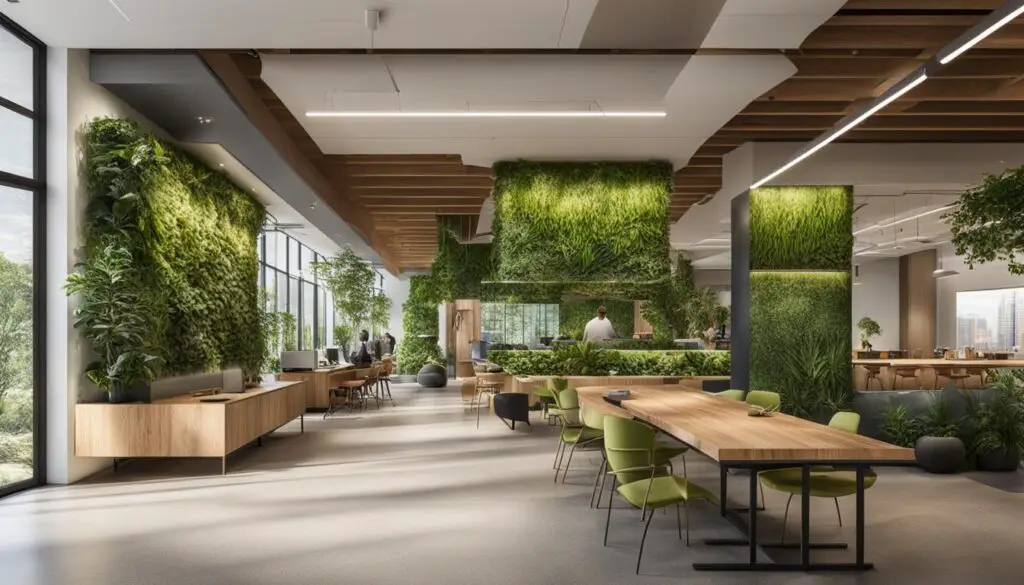
Key Benefits of Biophilic Design in Commercial Real Estate:
- Increased employee productivity and satisfaction
- Improved customer experience and satisfaction
- Higher occupancy rates for commercial properties
- Increased rental incomes for property owners
The Role of Biophilic Design in Sustainable Development
In today’s era of sustainable development, incorporating biophilic design principles into real estate projects has become a crucial aspect. Biophilic design is not only aesthetically pleasing but also promotes environmentally friendly practices, aligning perfectly with the principles of sustainable development. By integrating elements of nature into the built environment, such as vegetation, natural light, and organic materials, biophilic design enhances the overall sustainability and resilience of the property.
One of the key advantages of biophilic design in sustainable development is its ability to reduce energy consumption. By strategically incorporating natural light and ventilation, properties can rely less on artificial lighting and air conditioning systems, resulting in lower energy usage and reduced carbon emissions. This sustainable approach not only benefits the environment but also contributes to cost savings for property owners and occupants.
Another significant aspect of biophilic design in sustainable development is its positive impact on indoor air quality. By incorporating appropriate ventilation systems and natural greenery, biophilic design helps to filter and purify the indoor air, reducing the presence of harmful pollutants. This promotes a healthier living and working environment, benefiting the well-being of occupants and reducing the occurrence of respiratory problems.
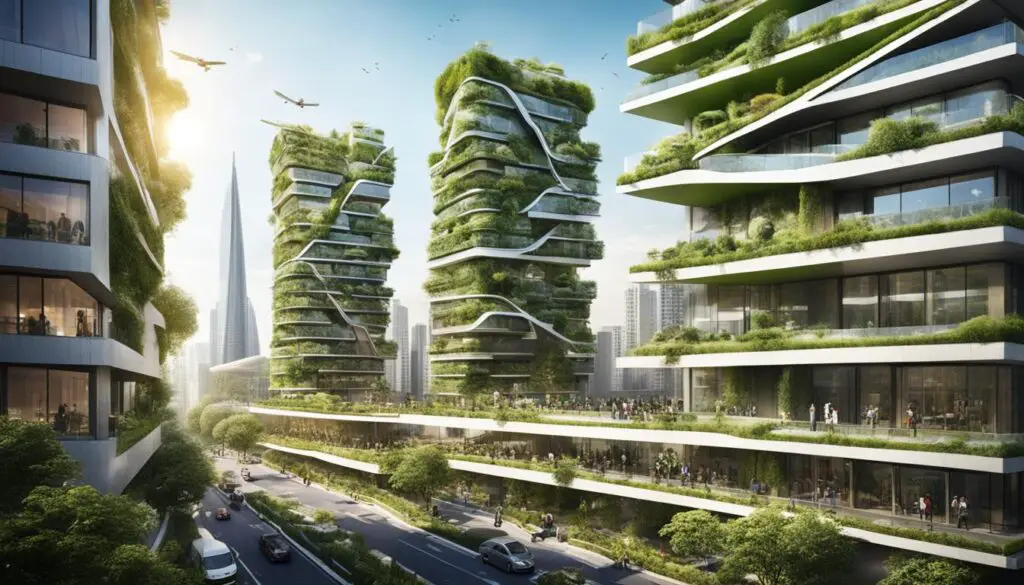
Furthermore, biophilic design enhances natural ventilation within the property, reducing the reliance on mechanical ventilation systems. This not only minimizes energy consumption but also improves the overall comfort of the occupants. The integration of features such as open courtyards, green roofs, or living walls facilitates the natural flow of fresh air, creating a pleasant and invigorating atmosphere.
“Biophilic design bridges the gap between the built environment and nature, creating sustainable and harmonious spaces that benefit both humans and the planet.” – Sustainable Design Expert
By incorporating biophilic design elements into real estate projects, developers can create properties that not only contribute to sustainable development but also attract environmentally conscious buyers and tenants. Properties that prioritize sustainability and well-being have a competitive edge in the market, appealing to individuals who value and prioritize a greener lifestyle.
To truly understand the impact of biophilic design in sustainable development, let’s take a look at a comparison between two properties:
| Traditional Property | Property with Biophilic Design |
|---|---|
| Higher energy consumption | Reduced energy consumption |
| Poor indoor air quality | Improved indoor air quality |
| Relying heavily on mechanical ventilation | Natural ventilation through well-planned design features |
| Less connection to nature | Strong connection to nature through integration of green spaces |
As shown in the comparison table, the property with biophilic design surpasses the traditional property in terms of energy efficiency, indoor air quality, natural ventilation, and connection to nature. These factors contribute to a more sustainable and desirable living or working environment, ultimately enhancing the overall value and marketability of the property.
In conclusion, biophilic design plays a vital role in sustainable development. By integrating nature into the built environment, biophilic design reduces energy consumption, improves indoor air quality, and enhances natural ventilation. Sustainable properties with biophilic design features have a competitive edge in the market, appealing to environmentally conscious buyers and tenants. Incorporating biophilic design principles into real estate projects is not only beneficial for the environment but also contributes to the well-being and satisfaction of the occupants. Embracing biophilic design is a step towards a more sustainable and harmonious future.
Biophilic Design Trends and Innovations
The field of biophilic design is constantly evolving, with new trends and innovations shaping the way we integrate nature into our built environment. These advancements not only enhance the aesthetic appeal of properties but also contribute to their overall value and desirability. Let’s explore some of the emerging trends in biophilic design and the exciting innovations that are revolutionizing the way we connect with nature.
Living Walls: Bringing Nature Indoors
One of the prominent trends in biophilic design is the use of living walls, also known as green walls or vertical gardens. These vertical installations feature a wide variety of plants, giving spaces a vibrant and natural atmosphere. Not only do living walls improve air quality by filtering pollutants, but they also enhance acoustic performance and create a visually appealing focal point. Whether it’s an office lobby, a retail space, or a residential interior, living walls offer a unique and effective way to integrate nature into our daily lives.
Biomimicry-Inspired Design: Nature’s Genius
Another fascinating trend in biophilic design is the incorporation of biomimicry-inspired elements. By emulating nature’s genius, architects and designers are creating structures and systems that mimic the patterns, processes, and functions found in the natural world. From solar panels designed like leaves to buildings that mimic termite mounds for natural ventilation, biomimicry-inspired design elements not only enhance sustainability but also offer innovative solutions for energy efficiency and resource conservation.
Smart Systems: Enhancing the Biophilic Experience
The integration of smart systems is yet another innovation revolutionizing biophilic design. Advanced technologies such as automated shading systems, intelligent lighting controls, and cutting-edge HVAC (heating, ventilation, and air conditioning) solutions are being leveraged to enhance the biophilic experience. These smart systems allow occupants to optimize their connection with nature, ensuring the right amount of natural light, thermal comfort, and air quality within the built environment. By seamlessly blending technology and nature, biophilic design becomes even more immersive and enjoyable.
Biophilic Design Innovations: A Game-Changer
As the demand for sustainable and nature-centric spaces continues to grow, the biophilic design industry is embracing innovative solutions that redefine our relationship with the built environment. The incorporation of living walls, biomimicry-inspired design, and smart systems are just a few examples of how biophilic design is evolving to create harmonious and health-enhancing spaces. These trends and innovations not only offer tangible benefits to occupants but also present exciting opportunities for property owners and developers to differentiate themselves in the market.
Listed below are some key takeaways from the biophilic design trends and innovations discussed in this section:
- Living walls provide a visually appealing and environmentally friendly way to bring nature indoors.
- Biomimicry-inspired design elements offer innovative and sustainable solutions.
- Smart systems enhance the biophilic experience by optimizing natural light, thermal comfort, and air quality.
- Biophilic design trends and innovations present opportunities for property owners and developers to create unique, value-added spaces.
By staying at the forefront of these trends and embracing innovative solutions, the real estate industry can unlock the full potential of biophilic design and create spaces that prioritize both human well-being and environmental sustainability.
Case Studies of Successful Biophilic Design Projects
Numerous case studies have provided compelling evidence of the success of biophilic design in real estate. These case studies demonstrate the tangible benefits and positive impact that biophilic design can have on the value and desirability of properties. Here are some notable examples:
Office Building with Green Roofs and Indoor Gardens
An office building located in downtown New York implemented biophilic design features such as green roofs and indoor gardens throughout the building. The incorporation of these natural elements has resulted in increased employee satisfaction, productivity, and overall well-being. Employees now have access to green spaces within the workspace, providing them with a closer connection to nature, improved air quality, and reduced stress levels.
“The biophilic design elements in our office have transformed the work environment. The green roofs and indoor gardens contribute to a sense of calmness and rejuvenation, which in turn has had a positive impact on our productivity and overall job satisfaction.” – Employee testimonial
Residential Development with Well-Designed Outdoor Spaces
A newly constructed residential development in California incorporated biophilic design principles to create well-designed outdoor spaces that mimic natural environments. The inclusion of features such as community gardens, walking trails, and water features has attracted higher demand among potential buyers. These properties have achieved premium prices due to the enhanced quality of living and the sense of connection to nature that they provide.
| Property Features | Demand | Price Premium |
|---|---|---|
| Community Gardens | High | +20% |
| Walking Trails | High | +15% |
| Water Features | Medium | +10% |
“Living in this biophilically designed residential community has been an incredible experience. The access to outdoor spaces and green amenities has significantly improved our quality of life and made us feel more connected to the environment.” – Resident testimonial
These case studies highlight the success stories of real estate projects that have implemented biophilic design principles. The incorporation of nature-inspired elements has not only enhanced the well-being of occupants but also resulted in increased demand, improved property value, and premium prices. These examples serve as inspiration for future projects seeking to harness the benefits of biophilic design.
Conclusion
Biophilic design is more than just visually appealing; it has a profound impact on the value of real estate. By integrating elements of nature into the built environment, biophilic design not only enhances the well-being of occupants but also increases property desirability. The incorporation of biophilic design principles can command higher prices or rental rates, making it a smart investment for property owners, developers, and investors.
As sustainable development and the emphasis on well-being continue to gain importance, biophilic design is poised to play a crucial role in the future of real estate. The positive psychological and physiological benefits of biophilic design create a healthier and more productive living and working environment. Additionally, the demand for environmentally friendly properties aligns perfectly with the sustainable practices promoted by biophilic design.
To maximize the value and benefits of real estate projects, it is essential for property owners, developers, and investors to consider biophilic design. By creating spaces that connect people with nature, biophilic design enhances not only the quality of habitation but also the overall experience of occupants. Whether it is a residential or commercial property, incorporating biophilic design elements is a strategic decision that can lead to increased property value, tenant satisfaction, and higher returns on investment.
FAQ
What is biophilic design?
Biophilic design goes beyond aesthetics and focuses on integrating elements of nature into the built environment, creating a harmonious and sustainable living space.
What are the benefits of biophilic design?
Biophilic design provides numerous psychological and physiological benefits to occupants, including reduced stress, increased productivity, improved cognitive function, better air quality, acoustics, and natural lighting.
How does biophilic design impact real estate value?
Properties with biophilic design features are perceived as more desirable and can command higher prices or rental rates due to the improved quality of living, connection to nature, and positive impact on well-being.
Does biophilic design only apply to residential properties?
No, biophilic design also has a significant impact on commercial real estate by increasing employee productivity, satisfaction, and overall customer experience.
How does biophilic design align with sustainable development?
Biophilic design promotes environmentally friendly practices by reducing energy consumption, improving indoor air quality, and enhancing natural ventilation, making it appealing to environmentally conscious buyers and tenants.
What are some emerging trends in biophilic design?
Some emerging trends include the use of living walls, green roofs, biomimicry-inspired design elements, and integration of smart systems that enhance the biophilic experience, such as automated shading systems and advanced HVAC controls.
Are there any successful case studies of biophilic design in real estate?
Numerous case studies have shown the success of biophilic design, including increased employee satisfaction and productivity in office buildings with green roofs and indoor gardens, and higher demand and premium prices for residential developments with well-designed outdoor spaces and access to nature.
Source Links
- https://www.businessinsider.in/thelife/news/americas-real-estate-market-could-see-a-1-trillion-default-wave-as-things-turn-very-ugly-billionaire-ceo-says/articleshow/107062049.cms
- https://www.realspace3d.com/blog/20-hot-home-features-for-2024/
- https://bristoluniversitypressdigital.com/monochap/book/9781529220544/ch008.xml



